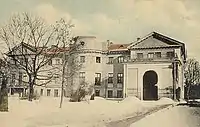Sanguszko
The House of Sanguszko[lower-alpha 1] is a Polish and Lithuanian noble and aristocratic family of Lithuanian and Ruthenian origin, connected to the Gediminid dynasty. Like other princely houses of Polish–Lithuanian Commonwealth, its origins are considered murky. Present historical opinion holds in favour of their descent from Algirdas' grandson Alexander (fl. 1433–1443), lord of Kovel and Liuboml, whose name can be shortened to Sangush. The family supposedly descends from two lines, associated with two of his sons, Alexander and Michael.
| Sanguszko | |
|---|---|
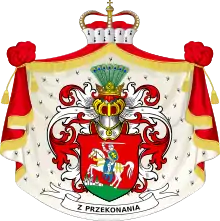 | |
| Current region | Poland, Ukraine |
| Place of origin | Volhynia |
| Connected families | Czartoryski |
The senior line, called the Sanguszko-Koszyrski, has been extinct since the death of Adam Aleksander Sanguszko in 1653. The junior line, or the Sanguszko-Kowelski, of Szymon Samuel Sanguszko, subsequently assumed the title Sanguszko-Lubartowicz, according to the erroneous assumption of their descent from Algirdas' younger brother Liubartas.
Prince Paweł Karol Sanguszko-Lubartowicz (1682–1752), a Court and Grand Marshal of Lithuania, greatly expanded his holdings through his second marriage with Marianna Lubomirska, heiress of Ostroh. His chief residence at Iziaslav (now in Ukraine) was embellished with a famous collection of Persian carpets, known as Sanguszko carpets. Hieronymous Sanguszko (1743–1812) founded the Volhynia stud, establishing the family as breeders of Arabian horses.
After the partitions of Poland, Eustachy Erazm Sanguszko fought in the Kościuszko Uprising and Napoleon's Russian campaign. His son, Prince Roman Sanguszko, was a Polish officer who participated in the November Uprising, and was exiled to Siberia. His life is the subject of "Prince Roman" (1910) one of Joseph Conrad's short stories. With the incorporation of Galicia into Soviet Ukraine after World War II, the Sanguszkos lost their Gumniska and Sławuta estates, as well as their palace in Lviv, and emigrated to Brazil.
By the late 20th century, the family was represented by a single descendant, Prince Paul (born 1973), who resides in São Paulo. His mother came from the Polignac lineage. In 2010 Olympia Sanguszko was born to Prince Paul and his wife.
Lineages
- koszyrsko-niesuchoiżska (Kamień Koszyrski-Niesuchojeże line) – split into two primary lineages:
- gałąź koszyrska – Sanguszkowie-Koszyrscy (Kamień Koszyrski branch) – the male branch died out in 1653; descendants in the female line still exist today in Kiev;
- gałąź niesuchoiżska – Sanguszkowie-Niesuchoiżscy (Niesuchojeże branch) – the branch died out in 1591;
- linia kowelska – Sanguszkowie-Kowelscy (Kowel line) – existing until today.
Notable members
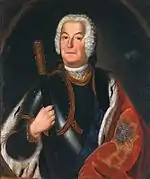
.jpg.webp)
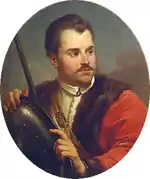
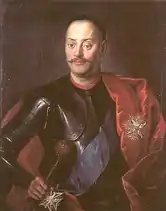
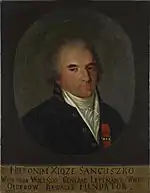
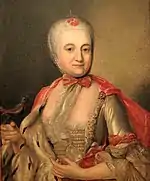
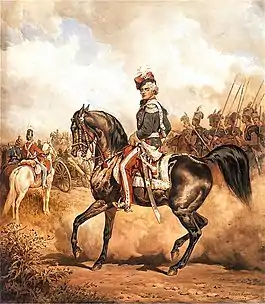
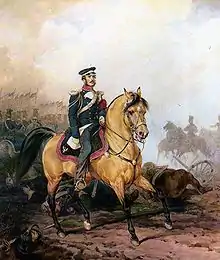
.jpg.webp)
Generation 0
- Alexander Feodorovich (died c. 1454), progenitor of the Sanguszko family
Generation 1
- Aleksander Sanguszkowic (died c. 1491), progenitor of the Sanguszko Kamień Koszyrski-Niesuchojeże line
- Michał Sanguszkowic (died c. 1511), progenitor of the Sanguszko Kowel line
- Ivan Sanguszkowic, progenitor of the Sadovski family
Generation 2
- Michał (died c. 1501)
- Andrzej Aleksandrowicz Sanguszko (died c. 1534/5), starost of Włodzimierz
- Wasyl Sanguszko (died c. 1557), courtier
Generation 3
- Andrzej Michałowicz Sanguszko (died 1560), marszałek hospodarski
- Fiodor Sanguszko (died 1547/8), starost of Włodzimierz, Bracław and Winnica
- Helena Andreevna Sangushko (1490–1561), Kamień Koszyrski branch, existing until today in Kiev
- Herhory (died 1555)
Generation 4
- Aleksander Sanguszko (c. 1508–1565), marszałek hospodarski
- Dymitr Sanguszko
- Roman Sanguszko (c. 1537–1571), voivode of Bracław, Field Hetman of Lithuania
- Andrzej Sanguszko (died. 1591)
Generation 5
- Lew Sanguszko (c. 1536–1571), rotmistrz of Lithuanian cavalry
- Lew-Roman Sanguszko (died 1591), the last member of the Sanguszko Niesuchojeże branch
- Samuel Szymon Sanguszko (died 1638), voivode of Witebsk, writer. He converted to Catholicism.
Generation 6
Generation 7
- Adam Aleksander Sanguszko (c. 1590–1653), voivode of Wołyń, the last member of the Sanguszko Kamień Koszyrski branch
- Hieronim (1651–1684)
Generation 8
- Kazimierz Antoni Sanguszko (1677–1706), Court Marshal of Lithuania
- Anna Katarzyna Radziwiłłowa (1676–1746)
- Paweł Karol Sanguszko (1680–1750), Court Marshal of Lithuania, Grand Marshal of Lithuania
- Barbara Urszula Sanguszkowa (1718–1791), poet, translator, philanthropist, wife of Paweł Karol
Generation 9
- Janusz Aleksander Sanguszko (1712–1775), miecznik, Court Marshal of Lithuania
- Józef Paulin Sanguszko (1740–1781), Grand Marshal of Lithuania
- Hieronim Janusz Sanguszko (1743–1812), general, voivode of Wołyń
- Janusz Modest Sanguszko (1749–1806), starost of Krzemieniec
Generation 10
- Tekla Teresa Lubienska (1767–1810), granddaughter of Barbara Urszula, playwright, poet and translator
- Eustachy Erazm Sanguszko (1768–1844), general, deputy and horse breeder
- Klementyna Maria Sanguszkowa (1780–1852), philanthropist
Generation 11
- Roman Stanisław Sanguszko (1800–1881), participated in the November Uprising in 1830, exiled to Siberia, subject of "Prince Roman" (1910), one of Joseph Conrad's short stories.
- Władysław Hieronim Sanguszko (1803–1870), conservative politician
- Dorota Sanguszko (1799–1821)
Generation 12
- Jadwiga Sanguszko (1830–1918), wife of Adam Stanisław Sapieha, mother of cardinal Adam Stefan Sapieha
- Roman Damian Sanguszko (1832–1917), ordynat of Zasław and collector
- Paweł Roman Sanguszko (1834–1876), landlord
- Eustachy Stanisław Sanguszko (1842–1903) marshal, namiestnik of Galicia
- Helena Sanguszko (1836–1891)
Generation 13
- Roman Władysław Sanguszko (1901–1984), landlord, horse breeder, industrialist and philanthropist
Generation 14
- Piotr Antoni Samuel Sanguszko (1937–1989)
Generation 15
- Paweł Franciszek Roman Sanguszko (born 1973), the last living member of the Sanguszko family
Palaces
Notes
- Lithuanian: Sanguškos, Belarusian: Сангушка, Ukrainian: Санґушко
External links
- (in English) Sanguszko at the Encyclopedia of Ukraine
- (in Polish) History of the family, Tarnów museum
- Sanguszko stallions
.jpg.webp)

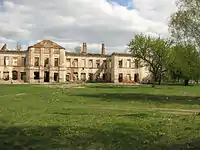

.jpg.webp)



